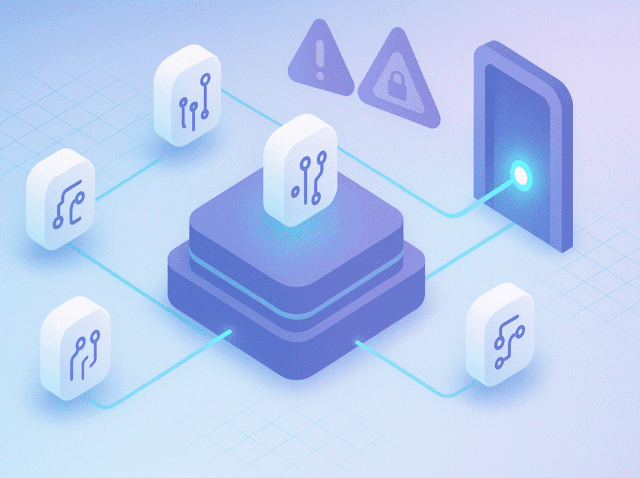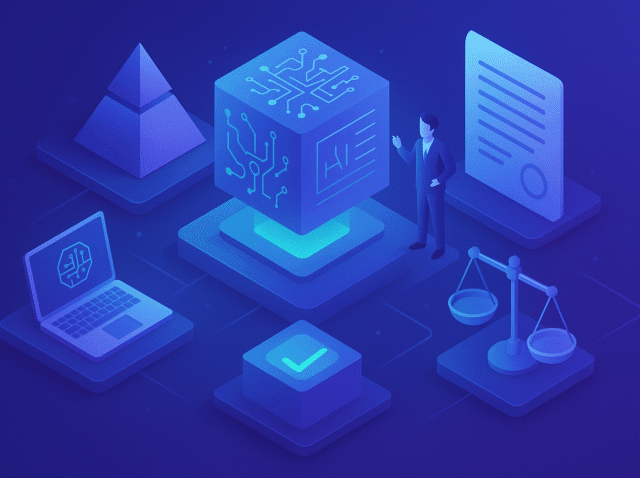What is Shadow AI?
Imagine a well-meaning employee pasting confidential company data into ChatGPT to get help with a report – without telling the IT or security team. This unsanctioned use of AI tools in an organization is known as “Shadow AI.” In simple terms, Shadow AI refers to employees or departments using artificial intelligence (especially generative AI like ChatGPT or code assistants) without the knowledge, approval, or oversight of their company’s IT, security, or compliance teams. It’s essentially the AI-specific version of “shadow IT,” where new tech is adopted behind the scenes.
Shadow AI has exploded in the workplace because AI tools are now widely accessible and incredibly easy to use. Workers across all roles – from developers and marketers to finance and legal staff – are experimenting with AI to boost productivity, often faster than their company can set rules or safeguards. Generative AI services are just a browser click away, and many employees aren’t waiting for official permission. In fact, recent research by Microsoft found that 75% of knowledge workers are already using AI at work, and 78% of those are bringing in AI tools on their own (so-called “BYOAI”) without formal approval. In short, employees see the value of AI and will use their preferred tools “whether or not IT has cleared them”. This gap between rapid AI adoption and lagging governance is the heart of the Shadow AI problem.
Shadow AI starts when employees use tools outside approved channels. Each use may seem minor, but together they create blind spots in data handling and security.
Why Shadow AI Is on the Rise
Several factors have led to the rise of Shadow AI in organizations:
- Widespread Availability: AI apps like ChatGPT, GitHub Copilot, or various AI chatbots are readily available online. Employees don’t need special technical skills or permission to access these tools – they can simply sign up and start using them. This ease of access means anyone in the company can adopt AI into their workflow instantly, often with free or personal accounts.
- Unmet Needs and Productivity Pressure: Employees often turn to Shadow AI when they have a job to do more efficiently, but no approved tool is provided. If the company hasn’t yet rolled out an official AI solution or guidelines, workers will use whatever helps them get the job done. From their perspective, using AI can save time on tedious tasks (summarizing documents, writing code, drafting emails) and help meet deadlines. In a recent Microsoft survey, 90% of workers said AI saves them time and helps them focus on important work. When people are struggling with heavy workloads or tight timelines, they’re inclined to grab any helpful tool – even if it’s unsanctioned – to improve productivity.
- Lack of Policies or Governance: Many organizations are playing catch-up when it comes to AI governance. Early on, companies may not realize how quickly employees are adopting these tools. Without clear policies saying what AI tools are allowed or how sensitive data can be handled, there’s effectively a governance void. This absence of guardrails makes it easy for shadow AI to flourish unnoticed. Employees often assume “no policy means it’s okay” or simply don’t consider the risks. As one industry report noted, “governance lag” is natural – workers innovate with new tech faster than security teams can set “sane policies and effective guardrails”.
The combination of these factors means Shadow AI isn’t an isolated phenomenon – it’s widespread. One study of hundreds of U.S. companies found 85% of security leaders suspect or know that shadow AI is being used in their organization, and about half had already confirmed specific instances. Shadow AI is not a “what if” problem for tomorrow; it’s happening today in the vast majority of organizations.
Data Privacy Risks of Shadow AI
When employees use AI tools under the radar, data privacy is often the first casualty. By its nature, Shadow AI means company data could be shared with external systems without anyone’s awareness. This creates several privacy and confidentiality concerns:
- Sensitive Data Leakage: Workers may unwittingly input all sorts of confidential information into AI prompts. For example, an employee might paste a customer list (with names, emails, or other personal identifiers) into a generative AI tool to draft a marketing email, or upload an internal document for summarization. Once that data is entered into a third-party AI service, it leaves the organization’s secure environment. The information could be stored on external servers and even used to train AI models, depending on the tool’s terms. This can easily result in personal data or trade secrets being exposed beyond their intended use.
- Regulatory Violations (GDPR, HIPAA, etc.): Privacy laws and regulations often require strict control over personal data. Shadow AI makes it hard to comply. For instance, under the EU’s GDPR or healthcare regulations like HIPAA, certain data can’t be transferred or processed by unvetted parties. If an employee in a European company uses an unapproved AI service that processes EU customer data, that could violate GDPR requirements on data handling and cross-border transfer. The organization might be none the wiser until a breach happens. As a tech lawyer cautioned, putting customer or patient information into unsanctioned AI “can trigger violations of regulations like GDPR or HIPAA or leak proprietary data”. These violations can lead to heavy fines (GDPR fines can reach 4% of global revenue) and legal consequences.
- Loss of Control and Consent: Even apart from formal regulations, companies have ethical obligations to protect personal information (of customers, employees, etc.). Shadow AI circumvents established controls like consent, data agreements, or retention policies. Data might be stored in ways the company never agreed to. Many free AI tools have very permissive terms of service, allowing them to retain and use input data for training or other purposes. That means any personal or sensitive data employees feed in could be repurposed or remain in the AI vendor’s systems indefinitely, outside of your control. This lack of oversight is a privacy nightmare – you likely don’t even know what personal data has left the building, so you can’t fulfill obligations like data breach notifications or data subject requests.
Compliance and Governance Challenges
Beyond privacy laws, Shadow AI creates a tangle of compliance and governance issues for organizations. If your company must follow industry regulations or internal policies, unsanctioned AI use can quietly undermine those requirements in several ways:
- Undocumented Data Processing: Many regulations (and good governance practices) require that organizations keep track of how data is collected, used, and shared. Shadow AI tools represent “invisible” data processing activities – data is being sent out to AI services, but it’s not logged or approved through normal channels. This means your official records (like a GDPR Article 30 record of processing or an internal data inventory) can be incomplete. In auditors’ eyes, that’s a compliance failure. You can’t protect or account for data you don’t even know is being processed elsewhere.
- Missing Vendor Agreements: Typically, when a company uses an external software or service that handles sensitive data, there are contracts and assessments in place – e.g. Data Processing Agreements, Business Associate Agreements (for healthcare), or vendor security reviews. Shadow AI tools often enter use with no such agreements or vetting. An employee might plug company info into a random AI SaaS app without any review of the tool’s security posture or legal terms. This lack of due diligence can itself violate requirements (for example, healthcare orgs are required to have BAAs for any service handling protected health info). It also means the organization hasn’t imposed any obligations on the AI provider about data use, retention, or breach notification.
- Loss of Trade Secrets and IP Protection: When proprietary data (code, designs, business strategies) is shared with a public AI, the company could lose its claim to that information as a trade secret. Trade secret laws often require that you take reasonable steps to keep information secret. Letting it slip into an external model that others might also interact with could be seen as failing to protect it. Additionally, if an AI’s output inadvertently incorporates your proprietary data and presents it to another user, you might have effectively disclosed your intellectual property. There’s even a patent angle – sharing inventions or code with a public system could count as public disclosure, undermining patent rights (similar to how posting in a public forum would). These are nuances that employees wouldn’t think about, but have real legal implications for IP compliance.
- Bypassing Security Controls and Audits: Shadow AI, by definition, circumvents the normal security checkpoints. Organizations invest in things like access controls, encryption, data loss prevention, and logging to protect data and ensure compliance. But if an employee is using an AI tool outside of approved channels, those security controls are bypassed. For example, an employee might use a personal account with an AI service on their work laptop – this might slip past corporate firewalls or proxies if not specifically blocked. No one is logging that activity or scanning those outputs for sensitive content. This creates blind spots in compliance audits and risk assessments. It also means if something goes wrong (say a data leak or a suspicious output), there’s no audit trail to investigate what happened. Lack of monitoring makes it nearly impossible to prove compliance or respond to incidents properly.
- Unreliable or Biased Outputs: While not a compliance violation in itself, AI-generated output can introduce compliance risks. Shadow AI tools might provide incorrect, biased, or unaccountable results. For instance, if an employee uses an AI to generate part of a financial report or some decision logic, and it’s wrong or discriminatory, who is accountable? Companies in regulated industries must often explain and document how decisions are made (think of credit scoring, hiring, or medical diagnoses). AI that operates in the shadows can produce content that violates regulations or company ethics (e.g., an AI-written customer response that accidentally promises something against policy, or code that doesn’t meet security standards). Moreover, using AI without proper review can lead to “unaccountable decision-making” – outcomes that management can’t justify to an auditor or regulator because they don’t even realize AI was involved. This can create legal liabilities and reputational damage. One dramatic example: lawyers at a law firm accidentally submitted a brief full of fabricated case citations generated by ChatGPT, because they didn’t verify the AI’s output. This not only resulted in a court sanction and embarrassment, but it demonstrates how unchecked AI use can compromise professional and compliance standards.
Cybersecurity Threats from Shadow AI
From a security perspective, Shadow AI introduces a host of new vulnerabilities and attack paths that organizations aren’t prepared for:
- Data Breaches and Leaks: The most immediate risk is that sensitive data ends up in places it shouldn’t, which is effectively a data breach. Even if it’s accidental, it’s a breach from the company’s point of view. Once company information is outside approved systems, it could be accessed by unauthorized parties. There have already been real cases – for example, in 2023, Samsung engineers inadvertently leaked proprietary source code by using ChatGPT to debug their software. Because of that incident, Samsung had to ban the use of external AI tools to prevent further leaks. This shows how a well-intentioned use of AI can create a serious security incident overnight. In fact, in one survey of medium-sized companies, a whopping 81% of firms that knew of Shadow AI use had already experienced a data breach or compliance issue because of it. Those are “headline-grabbing” incidents that no security team wants to see.
- Malicious Exploits and Vulnerabilities: Using unapproved AI tools can introduce unknown software into the environment, which might have its own security flaws. Any third-party app or browser extension employees install could potentially contain malware or open backdoors. Attackers are also keen on the AI trend – for instance, there have been cases of prompt injection attacks where an outsider tricks an AI system into revealing confidential info or doing something harmful. If employees start integrating AI outputs into business processes, a manipulated output could result in something like a flawed configuration or malicious code being introduced internally. A cybersecurity expert warned that “Shadow AI usage can result in malicious code, phishing attempts, or other security breaches going undetected until it’s too late.” In other words, bad actors might exploit the chaos of unsanctioned AI use: imagine an employee using a rogue AI tool that actually phishes them for login credentials, or an AI that suggests code with an intentional security hole. Without oversight, the company might not catch these issues until damage is done.
- No Monitoring or Incident Visibility: Normally, security teams have logs and monitoring for approved software. But if employees use AI tools outside official channels, security operations might have zero visibility into those interactions. If an incident occurs via a shadow AI channel (say an employee inadvertently exposed data or downloaded a risky script from an AI), it may not trigger any alerts. This lack of audit trail means breaches related to Shadow AI might only come to light much later, or through indirect clues. It’s quite possible that breaches are happening that “no one’s talking about” because they haven’t been detected yet. This blind spot is itself a huge risk – it’s hard to defend what you can’t see.
- Expanded Attack Surface: Unlike shadow IT which might be limited to certain tech-savvy teams, shadow AI can be adopted by anyone (even those who aren’t knowledgeable about security). This broad usage creates a wider attack surface. Every employee using an unsanctioned AI app is effectively another potential entry point or leak point for attackers. Additionally, AI models themselves are a new frontier – they can reveal sensitive info from training data, as seen when GitHub Copilot was found regurgitating private API keys it learned from public code. So an AI tool might leak data that didn’t even originate in your company, but could still pose security issues (like leaked credentials). All these factors mean security teams have to worry about threats that span beyond the traditional network or endpoint – the threat is also in the AI outputs and the external systems employees are engaging with.
The Bottom Line
For CIOs, CISOs, and GRC leaders, it’s a double-edged sword. On one side, you have the promise of AI-driven efficiency and innovation; on the other, the peril of data leaks, compliance landmines, and security vulnerabilities lurking in the shadows. The key takeaway is that Shadow AI is neither purely evil nor something to ignore. It’s a signal that employees need better solutions and that governance must catch up to technology.
In the end, dealing with Shadow AI is about enabling progress securely. It’s about saying “yes, but safely” instead of just “no.” With the strategies discussed above, security and compliance leaders can illuminate the dark corners where Shadow AI hides and ensure that their organization can innovate with AI confidently – without the shadows.








